
 |
| Home | Air-Air Missiles | Nukes | Air Operations | Search | Book Store |
| Covert Ops | Aircraft Data | Stealth | Smart Weapons | Glossary | Video Store |
| Vietnam War | Terrorism | Video Gallery | Image Gallery | News | Links |
 |

 |
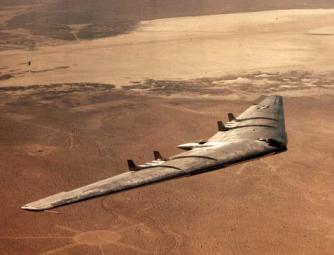 | America's Stealth Fighters and Bombers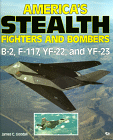 |
Flying Wings:
XB-35
YB-49
October 21, 1947. The first flight of the Northrop YB-49 flying wing jet bomber is made. The Air Force's Northrop B-2 stealth bomber will bear a family resemblance to this plane when it debuts in 1989.
| Type | Intercontinental Heavy Stealth Bomber |
| Crew | 2 |
| Length | 21.03 m (69 ft 0 in) |
| Height | 5.18 m (17 ft 0 in) |
| Wheel Track | 12.20 m (40 ft 0 in) |
| Wingspan | 52.43 m (172 ft 0 m) |
| Aspect Ratio | more than 5.92 |
| Wing Area | over 464.50 m2 ( 5,000.0 sq ft ) |
| Frontal Radar Cross-section | <1 m2 |
| Propulsion | Four General Electric F118-GE-110 non-afterburning turbofans |
| Engine Thrust | 84.52 kN ( 19,000 lb st ) |
| Empty Weight | 45,360-49,900 kg ( 100,000-110,000 lb ) |
| Max. Take-off Weight | 181437 kg ( 400,000 lb ) |
| Normal Take-off Weight | 168433 kg ( 371,330 lb ) |
| Max. Ordnance Load | 22680 kg ( 50,000 lb ) |
| Max. Internal Fuel | 81650 - 90720 kg ( 180,000-200,000 lb ) |
| Service Ceiling | 50,000 ft (15240 m) |
| Max. Level Speed | 416 knots 475 mph ( 764 km/h ) |
| Maximum Range | 10,000 nm 11,515 mi (18532 km) w/ one refuelling |
| Range with eight SRAMs and eight B61 nuclear bombs (24,000 lb 10886 kg warload total} | hi-hi-hi
6,600 nm 7,600 mi (12231 km) hi-lo-hi 4,500 nm 5,182 mi (8339 km) |
| Range with eight SRAMs and eight B83 nuclear bombs (37,300 lb 16919 kg warload total) | hi-hi-hi
6,300 nm 7,255 mi (11675 km) hi-lo-hi 4,400 nm 5,067 mi (8154 km) |
| Typical Weapon Load | 16 JDAM (Joint Direct Attack Munitions) 2,000 lb (907 kg) GPS guided bombs |
| Weapons Carried: | 16 AGM-129 ACMs. Alternative loadouts include 16 B61 or 16 B83 free-fall nuclear bombs; 80 Mk 82 500-lb bombs; 16 JDAM; 16 Mk 84 2,000-lb bombs; 36 M117 750-lb fire bombs; 36 CBU-87/89/97/98 cluster bombs; and 80 Mk 36 or Mk 62 sea mines. |
November 22, 1988. Northrop and the Air Force roll out the B-2 stealth bomber at Air Force Plant 42 in Palmdale, Calif.
July 17, 1989. Northrop Chief Test Pilot Bruce Hinds and Air Force Col. Richard Couch, director of the B-2 Combined Test Force, make the first flight of the Northrop B-2A advanced technology bomber, flying from Air Force Plant 42 in Palmdale, to the Air Force Flight Test Center at Edwards AFB.
1995:
Jan. 12: The wing launched three B-2s within 35 minutes of each other marking the first time this many B-2s had been in the air at one time. The three aircraft each completed air refueling, bombing, and pattern work, then turned for a record total of six B-2 sorties in one day.
Jan. 23: The 509th's B-2s made their first appearance at the periodic Red Flag exercise, held at Nellis AFB, Nev. The B-2s participated in the Red Flag exercise through 15 Feb 1995.
June 10-11: Piloted by Brigadier General Marcotte and Maj. Jimmy Smithers, the Spirit of Missouri traveled nonstop from Whiteman AFB to Paris, France, to conduct a flyover at the famous Paris Air Show. The B-2 landed at Paris for one hour where, and, with its engines still running, its crews were changed and it was flown back to Missouri. The 11-hour flight to Paris and 13-hour flight back to Whiteman marked the longest flight made by the B-2 fleet to date.
Sept. 1: The Spirit of Kansas flew to Honolulu to celebrate the 50th Anniversary of the U.S. victory over Japan during World War II. The trip marked the first B-2 mission over the Pacific Ocean.
Nov. 9: 509ers bid a fond farewell to the first B-2 to arrive at Whiteman, the Spirit of Missouri, as it returned to the Palmdale, Calif., assembly plant to undergo upgrade to Block 30 status.
Dec. 11: Whitemanites welcomed back the Spirit of Georgia after its naming ceremony at Robins AFB, Ga. Meanwhile, the Spirit of California escorted Georgia back to Whiteman, accomplishing the 509th B-2 sortie flown by the 509th Bomb Wing.
1996:
Jan. 24: The 509th Bomb Wing reached an important milestone when the 10th operational B-2 (90-0041 and soon to be called the Spirit of Hawaii) arrived. With this arrival, the wing had received half of its operational inventory.
Feb. 12: The first two-ship deployment of operational B-2s took place as a pair of the Spirit bombers winged their way to Andersen AFB, Guam. From there, a single B-2 flew on to Singapore for the Asian Aerospace ’96 Air Show. The re-maining B-2 flew sorties from Andersen AFB.
March 10-11: The Spirit of Washington made a flyover appearance at the FIDAE ‘96 Air Show in Santiago, Chile. The 24.5-hour flight produced the longest B-2 Spirit Global Power Mission to date.
May 16: The 11th B-2 (93-1085) and destined to be called the Spirit of Oklahoma arrived at Whiteman. This event marked another important milestone in the program because this bomber was the first combat capable as well as the first Block 20 B-2 to arrive.
July 8-12: The 509th received its first shipment of GBU-36 weapons, the highly accurate Global Positioning System-Aided Munitions (GAM) which utilized the GPS-Aided Targeting System (GATS).
Sept. 17: The 509th executed the first operational drop of the GBU-36. The three bombers involved dropped inert weapons within 7, 4 and 4ft, of the target respectively, at the Nellis AFB range complex.
Oct. 8: Three B-2s from the 509th successfully executed the first live drops of the GBU-36 weapons at the Nellis AFB range complex. Sixteen 2000-pound class GBU-36 were dropped against 16 targets from an altitude of more than 40,000ft, resulting in 16 kills. This demonstration marked the highest number of precision weapons ever released from one aircraft at the same time. The unprecedented accuracy encouraged the ACC commander, Gen. Richard Hawley, to declare limited (conventional) operational capability for the B-2 and the 509th Bomb Wing.
Nov. 7: ACC activated the 394th Combat Training Squadron at Whiteman and assigned the unit to the 509th BW.
Nov. 21: Flown by Col. James R. Macon, 509th BW vice wing commander, and Maj. Len Litton, the Spirit of Washington records the 509th’s 1,000th B-2 sortie.
1997:
Jan. 1: The 509th’s B-2 fleet became available to theater commanders-in-chief for use in conventional bombing roles.
Jan. 21-27: A team from the ACC Inspector General team evaluated the 509th under the guise of a Nuclear Surety Inspection. The wing passed the inspection thereby climbing another rung on the ladder to Initial Operational Capability.
Feb. 1: During Vigilant Spirit III, a 509th crew (Maj. Steve Moulton and Capt. Jeff Long) remained in the B-2 flight simulator after a 44.4-hour mission. The endurance test, monitored by officials from the Air Force’s Armstrong Lab, was the longest simulator ride to date.
Feb. 19: During GenEx 97-1, the B-2 conducted its first ever aircraft taxi exercise in response to receiving an emergency action message.
March 19-20: Maj. Rob O’Neal and Capt. Scott Hughes, 393 BS, flew a nonstop 28.9-hour mission under the guise of Coronet 97-2. Four aerial refuelings and a live conventional weapons release over the Vieguires Range, Puerto Rico, highlighted the mission.
April 1: The 509th attained initial operational capability with the B-2 Spirit. It had been approximately three and one-half years since the first B-2 arrived at Whiteman.
May 23-25: The 509th set another Global Power record when Maj. Scott Kramer, mission commander and Capt. Jeff Long, pilot, flew a 29.9-hour flight. The itinerary for the mission included a fly-over of the RAF Mildenhall, England, open house. On the way to and from England, the crew conducted numerous simulated bomb runs over middle America.
May 29: Maj. Stephen Chappel, 509th OG, and Captain Gary Konnert, B-2 Test Team member, Edwards AFB, Calif., dropped a GAM-113 from a B-2 for the first time. The aviators conducted the drop at the China Lake Range, California.
July 6-7: Majors Chris Inman and Steve Moulton set another Global Power flight record when they completed a 14,414-mile, 37-hour and 36-minute flight. During the venture, the crew flew from Whiteman to San Francisco, Honolulu and Wake Island before releasing a GAM at a bombing range near Guam.
Aug. 1: AV 20, soon to be named the Spirit of Pennsylvania, arrived at Whiteman. AV 20 held the distinction of being the first Block 30 B-2 assigned to the 509th.
Oct. 31: Eighth Air Force announced the 509th Bomb Wing had earned an Air Force Outstanding Unit Award for the period covering June 1, 1995-May 31, 1997.
1998:
Jan. 8: The 325th Bomb Squadron activated at Whiteman AFB and was assigned to the 509th. The unit became the 509th’s second operational squadron.
March 20: The 509th named its 18th B-2 the Spirit of Arizona during naming ceremonies at Davis-Monthan AFB, Ariz.
March 20: Approximately 250 509’ers deployed to Andersen AFB, Guam, via C-5A cargo planes, as part of Island Spirit, a 10-day Global Power exercise. Three days later, the Spirit of Louisiana and Spirit of Pennsylvania left Whiteman for Andersen AFB, Guam. All aircraft returned April 5 April while the deployed personnel arrived home during the week of April 12.
March 30: The Spirit of Pennsylvania dropped the first operational maximum load of Mk-82 500-pound bombs. The 40,000lb of live conventional weapons were targeted against a tiny island in the Farralon Range.
April 28: The 509th completed another "first" when it successfully dropped the new deep-penetrating Joint Direct Attack Munition. The test concluded after the releases of four JDAM-109s at the White Sands, N.M., range against buried targets.
Sept. 5-Oct. 13: Three B-2s from the 509th, along with a support contingency, deployed to Andersen AFB, Guam, for an extended Global Power mission exercise. While at the Pacific island, the B-2s integrated operations with the venerable B-52.
Sept. 22-24: More than 100 509ers participated in the base’s first Phase II exercise in preparation for the wing’s May 1999 Conventional Operational Readiness Inspection (CORI). The members ‘deployed’ to Base Y (southern end of Whiteman) and participated in various scenarios including base setup, aircraft removal, structural fire, and survive and operate exercises.
Nov. 30-Dec. 6: For the first time in B-2 history, 509ers conducted back to back Phase I and Phase II exercises in preparation for the upcoming CORI.
Dec. 17: The last of the Block 20 B-2s, the Spirit of Oklahoma, returned to Palmdale for upgrade to Block 30.
1999:
Feb. 10-11: During a Global Power mission, the Spirits of California and Washington left Whiteman for a bombing run near Andersen AFB, Guam. After successfully releasing the weapons, the aircraft landed at Andersen where they conducted an engine-running crew change before returning to Whiteman.
Feb. 11-12: The Spirits of South Carolina and Nebraska participated in a Global Power mission from Whiteman to the United Kingdom and back.
March 9-10: The Spirit of Arizona traveled to Royal Air Force Fairford for a Global Power mission.
March 24: In the first combat use of the Spirit bombers, two B-2s dropped bombs on targets in the Former Republic of Yugoslavia in support of NATO’s Operation Allied Force.
May 20: 509ers dedicated their newest B-2 as the Spirit of Indiana during ceremonies at Grissom Air Reserve Base, Ind.
May 21: The wing’s B-2s flew their last mission in support of Operation Allied Force. B-2 crews flew more than 45 30-hour missions, which was less than 1 percent of the missions. Crews dropped 11 percent of the bombs, which totaled 1.3 millionlb.
June 17: During a certified validation and verification of Whiteman’s hot pit refueling system, the Spirit of Mississippi pulled into the ‘pit’ to receive fuel. This was believed to be one of the first such operations done to the B-2.
July 19-27: A B-2 and 28 509ers flew to RAF Fairford to participate in the Royal Air Tattoo. This was the first time the B-2 had been on static display outside the United States.
Oct. 4-15: Four 325th Bomb Squadron B-2s flew in Spirit Hawk II at Mountain Home AFB, Idaho.
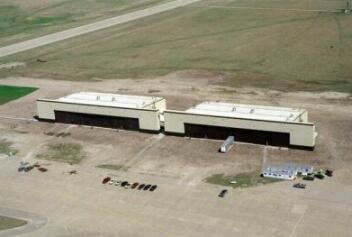
| Air Vehicle | Tail # | Name | Delivered to Air Force | Arrived Whiteman |
| AV-1 | 82-1066 | Fatal Beauty (Spirit of America) | 17 Jul 89 | scheduled for July 14, 2000 |
| AV-2 | 82-1067 | Spirit of ARIZONA | 19 Oct 90 | 20 Mar 98 |
| AV-3 | 82-1068 | Spirit of NEW YORK | 18 Jun 91 | 10 Oct 97 |
| AV-4 | 82-1069 | Spirit of INDIANA | 02 Oct 92 | 22 May 99 |
| AV-5 | 82-1070 | Spirit of OHIO | 05 Oct 92 | 18 Jul 97 |
| AV-6 TOV&V | 82-1071 | Spirit of MISSISSIPPI | 02 Feb 93 | 23 May 98 |
| AV-7 | 88-0328 | Spirit of TEXAS | 29 Aug 94 | 31 Aug 94 |
| AV-8 | 88-0329 | Spirit of MISSOURI | 11 Dec 93 | 17 Dec 93 |
| AV-9 | 88-0330 | Spirit of CALIFORNIA | 16 Aug 94 | 17 Aug 94 |
| AV-10 | 88-0331 | Spirit of S. CAROLINA | 29 Dec 94 | 30 Dec 94 |
| AV-11 | 88-0332 | Spirit of WASHINGTON | 27 Oct 94 | 30 Oct 94 |
| AV-12 | 89-0127 | Spirit of KANSAS | 16 Feb 95 | 17 Feb 95 |
| AV-13 | 89-0128 | Spirit of NEBRASKA | 26 Jun 95 | 28 Jun 95 |
| AV-14 | 89-0129 | Spirit of GEORGIA | 25 Sep 95 | 14 Nov 95 |
| AV-15 | 90-0040 | Spirit of ALASKA | 12 Jan 95 | 24 Jan 96 |
| AV-16 | 90-0041 | Spirit of HAWAII | 21 Dec 95 | 10 Jan 96 |
| AV-17 | 92-0700 | Spirit of FLORIDA | 29 Mar 96 | 3 Jul 96 |
| AV-18 | 93-1085 | Spirit of OKLAHOMA | 13 May 96 | 15 May 96 |
| AV-19 | 93-1086 | Spirit of KITTY HAWK | 30 Aug 96 | |
| AV-20 | 93-1087 | Spirit of PENNSYLVANIA | 05 Aug 97 | |
| AV-21 | 93-1088 | Spirit of LOUISIANA | 10 Nov 97 |
Air Vehicle - construction sequence of the stealth bomber program.
Tail numbers conform to regular Air Force convention: the first 2 digits give the year the plane was authorised, the last 4 digits are the aircraft's unique serial number.
Whiteman Air Force Base - only base that operates the B-2 bomber.
COL ANTHONY PRZYBYSLAWSKI - current commander.
location about sixty miles southeast of Kansas City, Missouri.
509th Bomb Wing
made up of the 393 Bomb Squadron (Activated on Aug. 27, 1993)
Lt. Col. Richard Y. Newton III Aug. 27, 1993
Lt. Col. Jonathon D. George Aug. 2, 1995
Lt. Col. Gregory A. Biscone Aug. 5, 1996
Lt. Col. Eric N. Single
June 16, 1998
325 Bomb Squadron.
on Jan. 6, 1998, the 325th returned to life amid ceremonies attended by Gen. Eugene Habiger, U.S. Strategic Air Command commander-in-chief (and a former 325th commander) and Lt. Gen. Phillip Ford, 8th Air Force commander. At the same time, Lt. Col. Will Gildner Jr., was placed in command of the 509th's newest squadron
The Air Force is accepting delivery of production B-2s in three configuration blocks--blocks 10, 20, and 30. Initial delivery will be 6 test aircraft, 10 aircraft in the block 10 configuration, 3 in the block 20 configuration, and 2 in the block 30 configuration.
Block 10 configured aircraft provide limited combat capability with no capability to launch conventional guided weapons. The Block 10 model carries only Mk-84 2,000-pound conventional bombs or gravity nuclear weapons. B-2s in this configuration are located at Whiteman Air Force Base and are used primarily for training.
Block 20 configured aircraft have an interim capability to launch nuclear and conventional munitions, including the GAM guided munition. The Block 20 has been tested with the Mk-84, 2,000-pound, general-purpose bombs and the CBU-87/B Combined Effects Munition cluster bombs (low-altitude, full-bay release). Block 30 configured aircraft are fully capable and meet the essential employment capabilities defined by the Air Force. The first fully configured Block 30 aircraft, AV-20 Spirit of PENNSYLVANIA, was delivered to the Air Force on 07 August 1997. Compared to the Block 20, the Block 30s have almost double the radar modes along with enhanced terrain-following capability and the ability to deliver additional weapons, including the Joint Direct Attack Munition and the Joint Stand Off Weapon. Other features include incorporation of configuration changes needed to make B-2s conform to the approved radar signature; replacement of the aft decks; installation of remaining defensive avionics functions; and installation of a contrail management system.
All block 10, 20, and test aircraft are to eventually be modified to the objective block 30 configuration. This modification process began in July 1995 and is scheduled to be completed in June 2000. The B-2 fleet will have 16 combat-coded aircraft by the second quarter of FY00.
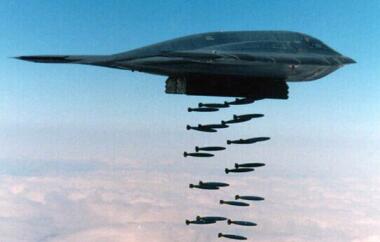
| Load out | Type | Function | Combat ready |
| 80 Mk 62 | Quick Strike Mine | quick minefield against subs and ships | Now |
| 80 MK82 | 500 lb bomb | attacking large spread out targets | Now |
| 34 CBU 87* | CEM | troop/vehicle concentrations, depots | Now |
| 34 CBU 89* | Gator | create instant minefield against armor/troops | Now |
| 34 CBU 97* | SFW | attack an area with AFVs in it | Now |
| 16 JDAM | 2,000 lb GPS-guided bomb | near-precision attacks | Now |
| 8 GBU-37 | 5,000 lb GPS-guided bomb | bunker buster | Now |
| 16 AGM-154 | JSOW | standoff attack | - |
The aircraft carries all its weapons internally and is fitted with two separate weapons bays in the centre of the aircraft. The B-2 has the capacity to carry up to 40,000 lb of weapons, including conventional and nuclear weapons, precision-guided munitions, gravity bombs and a range of maritime weapons.
Each weapons bay is equipped with a rotary launcher and two bomb rack assemblies. In tests, the B-2 successfully released B-61 and B-83 nuclear and Mk 84 conventional bombs from the rotary rocket launcher, and Mk-82 and CBU-87 conventional weapons from the bomb racks. The B61-11 is an earth-penetrating nuclear bomb for use against deeply buried and hardened targets. The B83 is a strategic free-fall nuclear bomb. The B-2 can also carry the AGM-129 Advanced Cruise Missile which is a strategic cruise missile with range estimated at up to 1,500 miles.
16 satellite-guided JDAM (Joint Direct Attack Munition) bombs can be carried. The aircraft will also be fitted with the JSOW (Joint Standoff Weapon) and Joint Air to Surface Standoff Missiles (JASSM) when these enter service.
A Generic Weapons Interface System (GWIS) has been fitted as part of the Block 30 upgrade. The GWIS is an integrated digital software package, which allows the B-2 to carry different mixes of standoff weapons and direct attack munitions on a single sortie, enabling the aircraft to attack up to four different types of targets on a single mission.
80 Mk 82, Mk 62
34 CBU 87/89/97 Cluster bombs
16 JDAM / Mk 84
8 GBU-37
16 B-83, B-61 nuclear bombs
AGM-154 JSOW (Joint Standoff Weapon) in 2003? and the AGM-158 JASSM (Joint Air to Surface Standoff Missile) in 2004?
Mk-62 Quick Strike Mine
nominal weight 500lb
weight 576 lb
length: 89 in
diameter: 15.1 in
CBU-97/CBU-105 Sensor Fuzed Weapon
CBU-89 Gator Mine, a 1,000-pound cluster munition containing antitank and antipersonnel mines, consists of a SUU-64 Tactical Munitions Dispenser with 72 antitank mines, 22 antipersonnel mines, and an optional FZU-39 proximity sensor
CBU-87/B Combined Effects Munitions (CEM) - The CBU-87 is a 1,000-pound, Combined Effects Munition (CEM) for attacking soft target areas with detonating bomblets. The CBU-87 CEM, an all-purpose, air-delivered cluster weapons system, consists of a SW-65 Tactical Munitions Dispenser (TMD) with an optional FZU-39 proximity sensor.
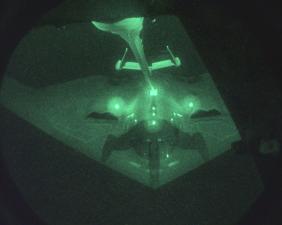
| Date | Operation | Area | Details |
| 1999 | Allied Force | Kosovo | 652 JDAMs droppd in 49 sorties |
| 2001-2002 | Enduring Freedom | Afghanistan | ? |
Over the course of Operation Allied Force, on critical targets in the Federal Republic of Yugoslavia. The Joint Direct Attack Munition is designated GBU-31, a 2,000-pound class munition guided by an $18,000 tail kit. (The GBU-37, which is similar to JDAM, includes a 5,000-lb class warhead and is also guided by a GPS tail kit.) During Operation Allied Force, the JDAM, which is still in low-rate production was employed at nearly the same rate that it is being manufactured. The B-2 was the only operational aircraft used to deliver JDAMs.
Six B-2s at Whiteman AFB particapated in Operation Allied Force, flying 30 hour non-stop missions involving four air-to-air refuelings (two on the way in and two on the way out) A total of 49 sorties were flown by the B-2 bombers during the campaign.
In addition to its normal weapons load of 16 GPS-guided GBU-31 JDAM, the B-2 also carried the 4700-lb GPS-guided GBU-37 bunker buster for special missions against deeply-buried or superhardened targets. the B-2 flew fewer than 1 percent of the total number of combat sorties yet dropped 11 percent (some 700) of the bombs delivered against targets in Yugoslavia and Kosovo all told. It also dropped a full third of all precision munitions expended during the campaign and proved itself capable of operating in weather that grounded all other allied combat aircraft.
Using rotary launchers in their internal weapons bays, each B-2 was able to carry and deliver up to 16 JDAM. A selectable fuse on each JDAM was set before the munition was loaded, and allowed for a variety of time delays - before or after impact - for the weapon's explosion.

| Dark Eagles |

| |||||||||||||